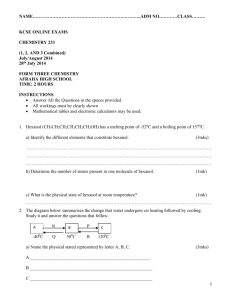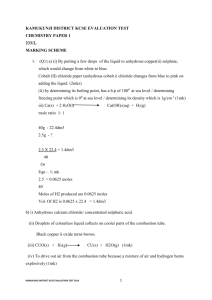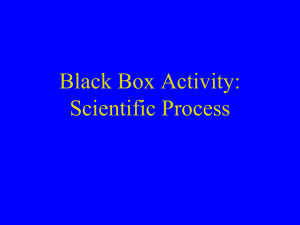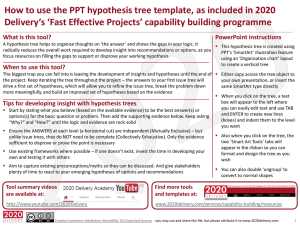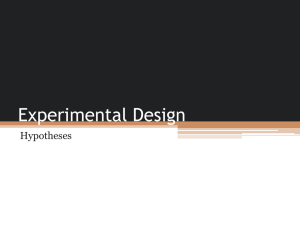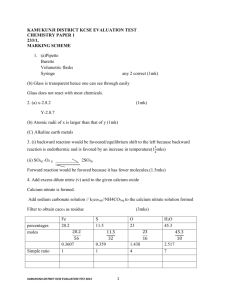Preparing of marking rubrics for assessing P/D and M/M
advertisement
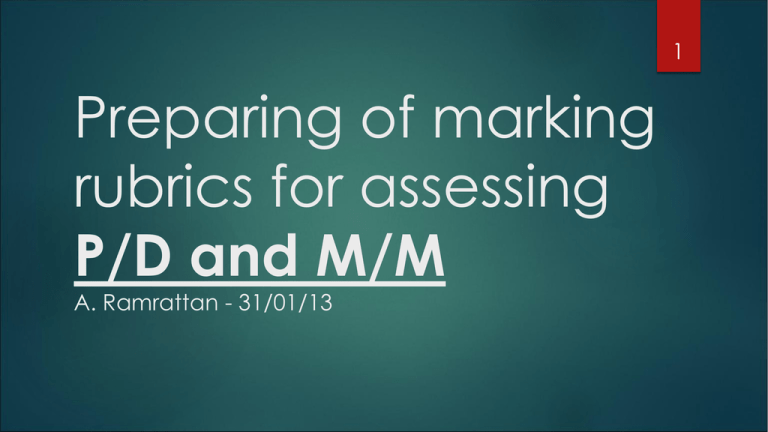
1 Preparing of marking rubrics for assessing P/D and M/M A. Ramrattan - 31/01/13 What are Hypotheses? 2 Dr. Jerry Pine, a scientist from Cal Tech stated in a National Science Foundation monograph: “Frequently the scientific method as taught by nonscientists requires that a scientific inquiry must stem from a hypothesis, which in fact is usually NOT true”(Institute for Inquiry 1999, p.61). Many of the great discoveries that stemmed from scientific inquiry were investigations into the unknown. There was insufficient prior knowledge or observations that could support an initial hypothesis that would guide these historic investigations. E.g. Charles Darwin did not have a hypothesis in mind when he set out on the Beagle and formulated his theory of natural selection. 3 Best Choices: A, B, G, K, L, & M Hypotheses be tested. are TENTATIVE explanations that can 4 They are NOT, as the popular moniker suggests, an “educated guess.” There is NO guessing involved. Hypotheses knowledge. Hypotheses are based on observation and prior are NOT investigative questions, nor are they questions posed at the BEGINNING of an investigation. 5 They are used to INVESTIGATE a question, guide the investigation, and determine what data to pay attention to. Hypotheses are NOT predications. Hypotheses provide a tentative explanation that can lead to a prediction. Predictions describe the outcome of an investigation but they do not include an explanation like a hypothesis does. NOT every investigation requires a hypothesis. A lot of science is observational and descriptive and MAY NOT involve hypotheses testing. When hypotheses are tested the results may support or refute a hypothesis. Hypotheses are not the first step to becoming a theory. 6 (Theory: A broad explanation, derived from the convergence of many hypotheses.) Hypotheses and theories are like apples and oranges – they have different features and a different purpose. Formulating hypotheses is a CREATIVE and IMAGINATIVE ENDEAVOR - very different from the STILTED hypotheses students develop from COOKBOOK labs. Like the “Scientific method,” there is NO lock-step, prescribed way to develop a hypothesis. It is helpful to frame a testable hypothesis using “If….then….because….” statement but NOT all hypotheses require that format. 7 a scientist who has been observing the effects of light on the behavior of a painted lady butterfly might hypothesize, “If exposed to light for 10 minutes or more minutes, then painted lady butterflies will become more active compared to those in shadows because we’ve noticed that butterflies outside in the garden seem to be more active in the sunlight.” e.g. A clearly written hypothesis highlights the INDEPENDENT and DEPENDENT variables and helps the scientist set up experiments. 8 9 In Summary… We can ask students to make a PREDICTION instead of a hypothesis because they lack the background knowledge or observations needed to develop a hypothesis. Dr. Jerry Pine said “If we don’t begin with a hypothesis, then what does initiate a scientific inquiry? A question….We can begin every scientific investigation with a question. If we insist on a hypothesis we will often merely force an unscientific guess” (Institute for Inquiry 1999, p. 61). 10 Designing an experiment 11 Defining the Problem/Developing an Hypothesis a) List all the factors which could influence the system under investigation or be responsible for an observation of interest. b) Think carefully about what you know or noticed about the process, for example, characteristics of the material, any theory you have learned, etc. c) Select the most likely factor, the one which you think is causing the observed effect. d) Write down the hypothesis. It must relate directly to the observation, make sense, deal with a single condition or variable and be testable. Experimental Design 12 a) Write out the aim of the experiment. b) List all the factors which might affect the process. c) Find a way to manipulate the variable you want to test, that is, to change it in a controlled way. d) List/describe the apparatus to be used. e) Take steps to ensure that none of the other variables will be affected or be able to change during your procedure. f) State the observations to be made or measurements to be taken, how often, how many times and how these will be recorded. g) State the limitations of the method, that is, any variables which are not controlled and which might affect the results. h) Write down how you will know whether or not the hypothesis is to be maintained/supported or rejected. There are 3 types of PD Labs: 13 Investigation of the FACTORS influencing the system under investigation: for e.g. Design an experiment to investigate how A and B vary with/depend on C II. Testing a HYPOTHESIS Fore e.g. Design an experiment to TEST/Investigate the truth of the statement/HYPOTHESIS that A is directly proportional to B, A/B is constant, as A is doubled, B is quartered iii. UNUSUAL Measurement for e.g. Design an experiment to MEASURE/FIND/DETERMINE ..e.g. breaking strength of a hair, density of ice by flotation. I. Criteria for assessing UNUSUAL measurement type Labs for PD 14 1. Appropriate apparatus/materials (if applicable) (1mk) 2. Diagram of set up (a) Large (1mk) (b) Well-Labelled (1mk) OR Circuit Diagram with appropriate arrangement (2mks) 3. Clear, workable method outlined in logical sequence (1mk) Including: a. Method of measuring physical quantities (1 per quantity) b. Repetition and averaging (1mk) 15 4. Calculations (1mk) 5. Treatment of results (if appropriate) (1mk) 6. Non-standard precautions used (1mk) 7. Safety precautions used (1mk) 8. Sources of error or danger identified (if appropriate) (1mk) Criteria for assessing (i) Hypothesis testing and (ii) Investigating factors, type labs. 16 1. HYPOTHESIS suggested (if appropriate) – Hypothesis should: be based on Physics Principles, relate to the observations, make sense, deal with 2 variables and be testable. (1mk) 2. Appropriate APPARATUS/MATERIALS listed (if applicable) (1mk) 3. DIAGRAM of set-up: (a) LARGE (1mk) (b) WELL-LABELLED (1mk) OR CIRCUIT DIAGRAM with appropriate arrangement (2 mks) 4. Clear, Workable METHOD outlined in a logical sequence (1mk) a. IDENTIFICATION of independent, dependent and control VARIABLES (1mk) 5. b. Method of MANIPULATING INDEPENDENT variable (1mk) 17 c. Method of MEASURING the INDEPENDENT variable (1mk) d. Method of MEASURING the DEPENDENT variable (1mk) e. Method of keeping the other variables CONSTANT (1mk) If lab executed: a. Equipment USED correctly (1mk) b. Equipment CALIBRATED (if necessary) (1mk) c. MODIFICATION of experiment if difficulties encountered (1mk) d. REPETITION and AVERAGING of results (1mk) 18 6. TREATMENT of results, i.e. appropriate GRAPH drawn (1mk) 7. Non-standard PRECAUTIONS (which improve accuracy) used (1mk) 8. SAFETY precautions used (where applicable) (1mk) 9. Sources of ERROR or DANGER identified (if appropriate) (1mk) 10. CONCLUSION (1mk) 11. Conclusion made supporting or refuting the aim/hypothesis JUSTIFIED (using data/graphs) (1mk) EXAMPLES OF P/D LABS AND “POSSIBLE” CRITERIA FOR ASSESSMENT Aim: 19 Find an approximate value for the energy released per gram of candle wax burnt. Criteria: 1. Determine initial mass of candle 2. Determine initial mass of water 3. Determine initial temperature of water 4. Heat water with candle flame 5. After water heated for a time, remove candle 6. Record the final temperature reached 7. Record the final mass of the candle 8. Energy released per gram = 9. Two possible sources of error Apparatus: A short piece of candle, 10cm fixed on metal lid, boiling tube and 40g of water, balance, thermometer, clamp and stand. Aim: Given a meter rule, a fulcrum and a standard 100g mass (1N weight) find the 20 weight of the meter rule. Criteria: 1. Outlines the appropriate theory 2. Generates an appropriate design 3. Repeats readings 4. Averages readings 5. Identifies possible sources of error and states precautions taken to reduce them Apparatus: meter rule, 100g mass, simple fulcrum Investigate whether the rebound height, hr has a constant relationship with the 21 original height, ho for a table tennis ball that is released from rest and bounces on the laboratory bench. A student suggest that: “The denser the metal the higher its specific heat capacity.” Test this hypothesis. “The resistance of a metallic conductor does not change as the potential difference across it varies” Investigate whether the statement above is true for the filament of the light bulb provided, using potential differences between 1V and 2.6V. Explain your conclusion. Investigate the relationship between the angle of incidence (i) and the lateral displacement (d) for the passage of a light ray through a rectangular glass block. You are provided with three sealed match-boxes A, B and C each with terminals at both ends. One of the match boxes has nothing inside, one has a piece of resistance wire between the terminals and one has a working diode between the terminals. Using any of the electrical apparatus with which you are familiar, design and perform an investigation to identify the contents of each box. A student’s mother who runs a cottage industry states that the hot syrups she cool 22 more easily than hot water. Test her suggestion. *PAST CXC LABS SUGGESTED FOR P/D* 1. In a glass block experiment, a student suggests that i > r for all angles of incidence, investigate the validity of this statement. 2. Height of rebound. 3. Drinking straw – internal diameter. 4. Dry cell. 5. Angle of incidence related to lateral displacement. 6. Beads acceleration in oil. 7. Determining the thickness of a foil. 9. Nature of electrical components. 10. Period of bent wire. 11. A student suggest that if the angle of incidence is doubled then the angle of reflection is also doubled. 12. A student suggests that by halving the voltage the power output is quartered for (i) a filament lamp, (ii) carbon resistor. 13. Density of salt solution. 14. Ice melts faster in salt water than in fresh water. 15. Period of a pendulum is proportional (depends) on the number of paper clips. 23 8. A student suggests that steam is hotter than boiling water. 16. The period of a pendulum depends on the material of 24 suspension. 17. Determining the length of a resistance wire in the form of a coil without unraveling it. 18. Determining whether or not the speed of a wave is affected by the density of the liquid. 19. Does the efficiency of a pulley system depend on the weight of the moving pulley? 20. The focal length of boiling tube depends on the liquid inside. 21. Investigate whether the shape of a solid affects the rate of which it falls through a liquid. 22. Investigate induction. how the shape of a soft iron core affects mutual 23. The energy value of a candle. 24. Sawdust and Styrofoam – thermal differences. Questions?? 25
